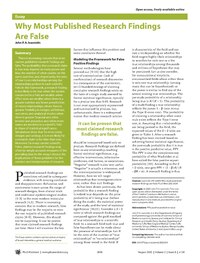
Photo from wikipedia
Findings from animal experiments are often difficult to transfer to humans. In this perspective article I discuss two questions. First, why are the results of animal experiments often so difficult… Click to show full abstract
Findings from animal experiments are often difficult to transfer to humans. In this perspective article I discuss two questions. First, why are the results of animal experiments often so difficult to transfer to humans? And second, what can be done to improve translation from animal experiments to humans? Translation failures are often the result of poor methodology. It is not merely the fact that low statistical power of basic and preclinical studies undermine a “real effect,” but the accuracy with which data from animal studies are collected and described, and the resulting robustness of the data is generally very low and often does not allow translation to a much more heterogeneous human condition. Equally important is the fact that the vast majority of publications in the biomedical field in the last few decades have reported positive findings and have thus generated a knowledge bias. Further contributions to reproducibility and translation failures are discussed in this paper, and 10 points of recommendation to improve reproducibility and translation are outlined. These recommendations are: (i) prior to planning an actual study, a systematic review or potential preclinical meta-analysis should be considered. (ii) An a priori power calculation should be carried out. (iii) The experimental study protocol should be pre-registered. (iv) The execution of the study should be in accordance with the most recent ARRIVE guidelines. (v) When planning the study, the generalizability of the data to be collected should also be considered (e.g., sex or age differences). (vi) “Method-hopping” should be avoided, meaning that it is not necessary to use the most advanced technology but rather to have the applied methodology under control. (vii) National or international networks should be considered to carry out multicenter preclinical studies or to obtain convergent evidence. (viii) Animal models that capture DSM-5 or ICD-11 criteria should be considered in the context of research on psychiatric disorders. (ix) Raw data of publication should be made publicly available and should be in accordance with the FAIR Guiding Principles for scientific data management. (x) Finally, negative findings should be published to counteract publication bias. The application of these 10 points of recommendation, especially for preclinical confirmatory studies but also to some degree for exploratory studies, will ultimately improve the reproducibility and translation of animal research.
Journal Title: Frontiers in Behavioral Neuroscience
Year Published: 2022
Link to full text (if available)
Share on Social Media: Sign Up to like & get
recommendations!